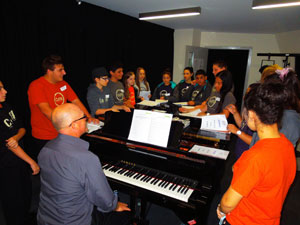
OFFICIAL STATEMENT
FROM VATICAN.VA
Dear Brothers,
I have convoked you to this Consistory, not only for the three canonizations, but also to communicate to you a decision of great importance for the life of the Church. After having repeatedly examined my conscience before God, I have come to the certainty that my strengths, due to an advanced age, are no longer suited to an adequate exercise of the Petrine ministry. I am well aware that this ministry, due to its essential spiritual nature, must be carried out not only with words and deeds, but no less with prayer and suffering. However, in today’s world, subject to so many rapid changes and shaken by questions of deep relevance for the life of faith, in order to govern the bark of Saint Peter and proclaim the Gospel, both strength of mind and body are necessary, strength which in the last few months, has deteriorated in me to the extent that I have had to recognize my incapacity to adequately fulfill the ministry entrusted to me. For this reason, and well aware of the seriousness of this act, with full freedom I declare that I renounce the ministry of Bishop of Rome, Successor of Saint Peter, entrusted to me by the Cardinals on 19 April 2005, in such a way, that as from 28 February 2013, at 20:00 hours, the See of Rome, the See of Saint Peter, will be vacant and a Conclave to elect the new Supreme Pontiff will have to be convoked by those whose competence it is. (IMAGE SHARE RADIO VATICANA)
Dear Brothers, I thank you most sincerely for all the love and work with which you have supported me in my ministry and I ask pardon for all my defects. And now, let us entrust the Holy Church to the care of Our Supreme Pastor, Our Lord Jesus Christ, and implore his holy Mother Mary, so that she may assist the Cardinal Fathers with her maternal solicitude, in electing a new Supreme Pontiff. With regard to myself, I wish to also devotedly serve the Holy Church of God in the future through a life dedicated to prayer.
From the Vatican, 10 February 2013
RADIO VATICANA -
Before midday on Monday Pope Benedict XVI announced his resignation which will officially take effect at the end of the month, at 8pm on February 28th.
The statement of his resignation, read by the Pope in Latin, states clearly that his “advanced age” and his declining physical strength “are no longer suited to an adequate exercise of the Petrine ministry”
WHO IS IN CHARGE NOW? (WIKIPEDIA)
Canon law makes no provision for a Pope being incapacitated for reasons of health, either temporarily or permanently; nor does it specify what body has the authority to certify that the Pope is incapacitated.[10] It does state that "When the Roman See is vacant, or completely impeded, no innovation is to be made in the governance of the universal Church."[11]
search
Dear Brothers,
I have convoked you to this Consistory, not only for the three canonizations, but also to communicate to you a decision of great importance for the life of the Church. After having repeatedly examined my conscience before God, I have come to the certainty that my strengths, due to an advanced age, are no longer suited to an adequate exercise of the Petrine ministry. I am well aware that this ministry, due to its essential spiritual nature, must be carried out not only with words and deeds, but no less with prayer and suffering. However, in today’s world, subject to so many rapid changes and shaken by questions of deep relevance for the life of faith, in order to govern the bark of Saint Peter and proclaim the Gospel, both strength of mind and body are necessary, strength which in the last few months, has deteriorated in me to the extent that I have had to recognize my incapacity to adequately fulfill the ministry entrusted to me. For this reason, and well aware of the seriousness of this act, with full freedom I declare that I renounce the ministry of Bishop of Rome, Successor of Saint Peter, entrusted to me by the Cardinals on 19 April 2005, in such a way, that as from 28 February 2013, at 20:00 hours, the See of Rome, the See of Saint Peter, will be vacant and a Conclave to elect the new Supreme Pontiff will have to be convoked by those whose competence it is. (IMAGE SHARE RADIO VATICANA)
Dear Brothers, I thank you most sincerely for all the love and work with which you have supported me in my ministry and I ask pardon for all my defects. And now, let us entrust the Holy Church to the care of Our Supreme Pastor, Our Lord Jesus Christ, and implore his holy Mother Mary, so that she may assist the Cardinal Fathers with her maternal solicitude, in electing a new Supreme Pontiff. With regard to myself, I wish to also devotedly serve the Holy Church of God in the future through a life dedicated to prayer.
From the Vatican, 10 February 2013
RADIO VATICANA -
Before midday on Monday Pope Benedict XVI announced his resignation which will officially take effect at the end of the month, at 8pm on February 28th.
The statement of his resignation, read by the Pope in Latin, states clearly that his “advanced age” and his declining physical strength “are no longer suited to an adequate exercise of the Petrine ministry”
WHO IS IN CHARGE NOW? (WIKIPEDIA)
Canon law makes no provision for a Pope being incapacitated for reasons of health, either temporarily or permanently; nor does it specify what body has the authority to certify that the Pope is incapacitated.[10] It does state that "When the Roman See is vacant, or completely impeded, no innovation is to be made in the governance of the universal Church."[11]
search
Sede vacante is an expression, used in the Canon Law of the Catholic Church and the Church of England, that refers to the vacancy of the episcopal see of a particular church. It is Latin for "the seat being vacant" (the ablative absolute of sedes vacans "vacant seat"), the seat in question being the cathedra of the particular church.
After the death or resignation of a pope the Holy See becomes sede vacante. In this case the particular church is the Diocese of Rome and the "vacant seat" is the cathedra of Saint John Lateran, the cathedral church of the bishop of Rome. During this period, the Holy See is administered by a regency of the College of Cardinals.
According to Universi Dominici Gregis, the government of the Holy See sede vacante (and therefore of the Catholic Church) falls to the College of Cardinals, but in a very limited capacity
HISTORY OF POPES RESIGNING (WIKIPEDIA)
The Catholic Encyclopedia notes that one catalogue of popes has Pope John XVIII resigning office in 1009 and ending his life as a monk.[4][5]
In 1045, in order to rid the Church of the scandalous Pope Benedict IX, Pope Gregory VI paid Benedict to resign the papacy in his favour.[6] Gregory himself resigned in 1046 because the arrangement he had entered into with Benedict was considered simony. Gregory's successor, Pope Clement II, died in 1047 and Benedict IX became Pope again.
The best-known resignation of a Pope is that of Pope Celestine V in 1294. After only five months of pontificate, he issued a solemn decree declaring it permissible for a Pope to resign, and then did so himself. He lived two more years as a hermit and then prisoner of his successor Pope Boniface VIII and was later canonised. The Papal decree that he issued ended any doubt among canonists about the possibility of a valid Papal resignation.
Pope Gregory XII (1406-1415), resigned in order to end the Western Schism, which had reached the point where there were three claimants to the Papal throne: Roman Pope Gregory XII, Avignon Antipope Benedict XIII, and Pisan Antipope John XXIII. Before resigning he formally convened the already existing Council of Constance and authorized it to elect his successor.
On 11 February 2013, the Vatican announced that Pope Benedict XVI would resign effective 28 February, due to infirmity from advanced age.[7] He is the first pope to resign since Gregory XII in 1415.
After the death or resignation of a pope the Holy See becomes sede vacante. In this case the particular church is the Diocese of Rome and the "vacant seat" is the cathedra of Saint John Lateran, the cathedral church of the bishop of Rome. During this period, the Holy See is administered by a regency of the College of Cardinals.
According to Universi Dominici Gregis, the government of the Holy See sede vacante (and therefore of the Catholic Church) falls to the College of Cardinals, but in a very limited capacity
HISTORY OF POPES RESIGNING (WIKIPEDIA)
The Catholic Encyclopedia notes that one catalogue of popes has Pope John XVIII resigning office in 1009 and ending his life as a monk.[4][5]
In 1045, in order to rid the Church of the scandalous Pope Benedict IX, Pope Gregory VI paid Benedict to resign the papacy in his favour.[6] Gregory himself resigned in 1046 because the arrangement he had entered into with Benedict was considered simony. Gregory's successor, Pope Clement II, died in 1047 and Benedict IX became Pope again.
The best-known resignation of a Pope is that of Pope Celestine V in 1294. After only five months of pontificate, he issued a solemn decree declaring it permissible for a Pope to resign, and then did so himself. He lived two more years as a hermit and then prisoner of his successor Pope Boniface VIII and was later canonised. The Papal decree that he issued ended any doubt among canonists about the possibility of a valid Papal resignation.
Pope Gregory XII (1406-1415), resigned in order to end the Western Schism, which had reached the point where there were three claimants to the Papal throne: Roman Pope Gregory XII, Avignon Antipope Benedict XIII, and Pisan Antipope John XXIII. Before resigning he formally convened the already existing Council of Constance and authorized it to elect his successor.
On 11 February 2013, the Vatican announced that Pope Benedict XVI would resign effective 28 February, due to infirmity from advanced age.[7] He is the first pope to resign since Gregory XII in 1415.
CATHOLIC MOVIES - WATCH THE MOTHER TERESA - PART 8
IN HONOUR OF THE YEAR OF FAITH JCE NEWS WILL BE
SHOWING SOME OF THE BEST CATHOLIC FILMS OF ALL TIME - MOTHER TERESA -
AFRICA : SOMALIA : LAND MINES THREATEN COUNTRY
CISA NEWS REPORT
 MOGADISHU, February 08, 2013
(CISA) -Thousands of land mines and other unexploded ordnance (UXO) scattered in
different parts of Somalia during the last decades of conflict are, creating a
new source of threat to the security the country, according to a Fides News
report. Experts say that Somalia lacks the appropriate equipment for clearing
weapons of war.
MOGADISHU, February 08, 2013
(CISA) -Thousands of land mines and other unexploded ordnance (UXO) scattered in
different parts of Somalia during the last decades of conflict are, creating a
new source of threat to the security the country, according to a Fides News
report. Experts say that Somalia lacks the appropriate equipment for clearing
weapons of war.
The eastern border of Somalia-Ethiopia is reported to have many UXOs.
According to the Office of the United Nations that deals with anti-mine actions (UNMAS), there is also a threat from factories that keep explosives, abandoned weapons, ammunition and explosive devices (IEDs). UNMAS argues that most of southern and central Somalia is ridden with explosive remnants of war (ERW).
In 2012, at least eight children died in an explosion in the town of Balad in Middle Shabelle Region. According to UNMAS, in 2011, landmines caused 4% of deaths and injuries in Somalia, while UXO caused 55%. Somalia signed the Anti-Personnel Mine Ban Convention in 2012 that involves the destruction of the remnants of war within four years. In the last five years over 21,461 UXO and landmines have been destroyed in Somalia.
SHARED FROM CISA NEWS

The eastern border of Somalia-Ethiopia is reported to have many UXOs.
According to the Office of the United Nations that deals with anti-mine actions (UNMAS), there is also a threat from factories that keep explosives, abandoned weapons, ammunition and explosive devices (IEDs). UNMAS argues that most of southern and central Somalia is ridden with explosive remnants of war (ERW).
In 2012, at least eight children died in an explosion in the town of Balad in Middle Shabelle Region. According to UNMAS, in 2011, landmines caused 4% of deaths and injuries in Somalia, while UXO caused 55%. Somalia signed the Anti-Personnel Mine Ban Convention in 2012 that involves the destruction of the remnants of war within four years. In the last five years over 21,461 UXO and landmines have been destroyed in Somalia.
SHARED FROM CISA NEWS






No comments:
Post a Comment